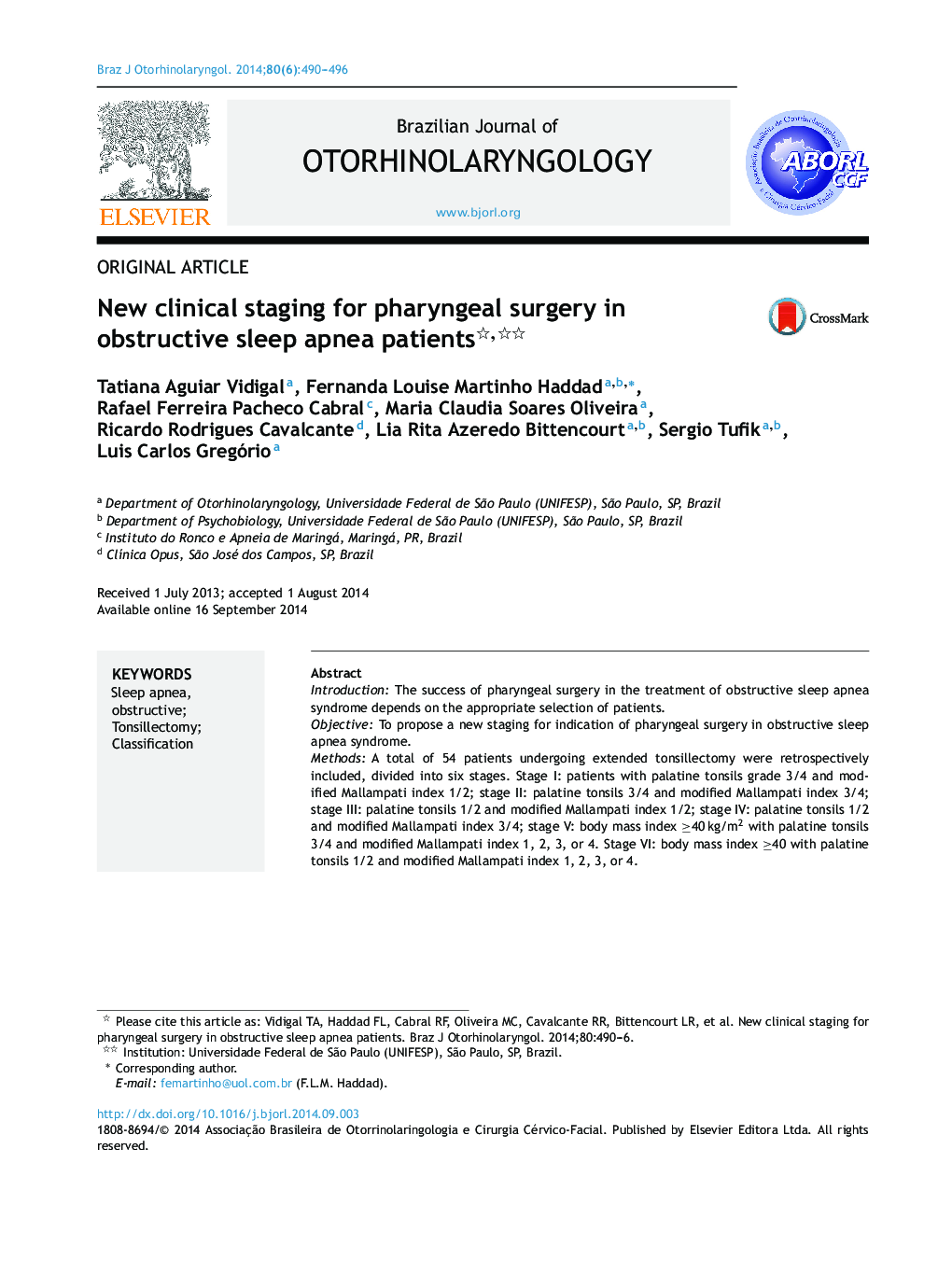| کد مقاله | کد نشریه | سال انتشار | مقاله انگلیسی | نسخه تمام متن |
|---|---|---|---|---|
| 4106192 | 1605371 | 2014 | 7 صفحه PDF | دانلود رایگان |
IntroductionThe success of pharyngeal surgery in the treatment of obstructive sleep apnea syndrome depends on the appropriate selection of patients.ObjectiveTo propose a new staging for indication of pharyngeal surgery in obstructive sleep apnea syndrome.MethodsA total of 54 patients undergoing extended tonsillectomy were retrospectively included, divided into six stages. Stage I: patients with palatine tonsils grade 3/4 and modified Mallampati index 1/2; stage II: palatine tonsils 3/4 and modified Mallampati index 3/4; stage III: palatine tonsils 1/2 and modified Mallampati index 1/2; stage IV: palatine tonsils 1/2 and modified Mallampati index 3/4; stage V: body mass index ≥40 kg/m2 with palatine tonsils 3/4 and modified Mallampati index 1, 2, 3, or 4. Stage VI: body mass index ≥40 with palatine tonsils 1/2 and modified Mallampati index 1, 2, 3, or 4.ResultsThe surgical success rates were 88.9%, 75.0%, 35.7%, 38.5%, and 100.0% in stages I–V.ConclusionThe presence of hypertrophic palatine tonsils was the anatomical factor in common in the most successful stages (I, II, and V), regardless of body mass index. Although the modified Mallampati index classes 3 and 4 reduced the success rate of surgery in patients with hypertrophic tonsils (stage II), the presence of modified Mallampati index classes 1 and 2 did not favor surgical success in patients with normal tonsils (stage III).
ResumoIntroduçãoO sucesso da cirurgia faríngea no tratamento da síndrome da apnéia obstrutiva do sono (SAOS) depende da adequada seleção de pacientes.ObjetivoPropor um novo estadiamento para indicação de cirurgia faríngea na SAOS.MétodoEstudo retrospectivo, onde foram inclusos, 54 pacientes submetidos a amigdalectomia ampliada, divididos em 6 estádios. Estádio I: pacientes com tonsilas palatinas graus 3/4 e índice de Mallampati modificado (IMM) 1/2; Estádio II: tonsilas palatinas 3/4 e IMM 3/4; Estádio III: tonsilas palatinas 1/2 e IMM 1/2; Estádio IV: tonsilas palatinas 1/2 e IMM 3/4; Estádio V: IMC (índice de massa corpórea) ≥ com tonsilas palatinas 3/4 e IMM 1,2,3 ou 4. Estádio VI: IMC ≥ kg/m2 com tonsilas palatinas 1ou2 e IMM 1, 2, 3, ou 4.ResultadosAs taxas de sucesso cirúrgico foram de 88,9%; 75,0%; 35,7%; 38,5% e 100,0% nos estádios I a V.ConclusãoA presença de tonsilas palatinas hipertróficas foi o fator anatômico em comum nos estádios de maior sucesso (I, II e V), independente do IMC. Apesar do IMM classe III e IV diminuir a taxa de sucesso da cirurgia em pacientes com tonsilas hipertróficas (estádio II), a presença de IMM classe I e II não favoreceu o sucesso cirúrgico em pacientes com tonsilas normotróficas (estádio III).
Journal: Brazilian Journal of Otorhinolaryngology - Volume 80, Issue 6, November–December 2014, Pages 490–496
